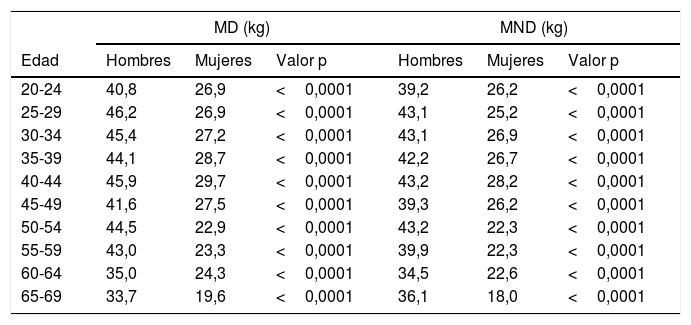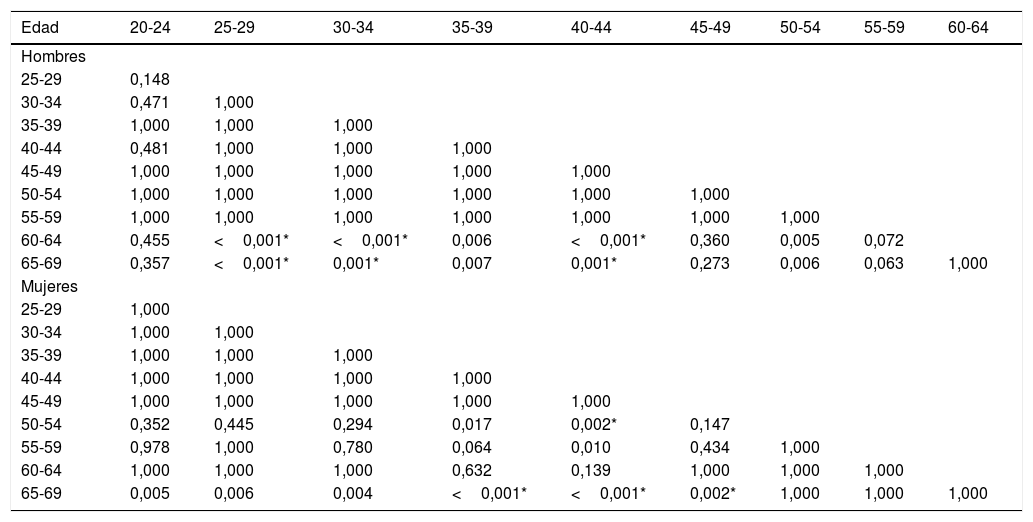El objetivo de este estudio es caracterizar el rendimiento de fuerza prensil de las manos dominante y no dominante de hombres y mujeres entre 20 y 69 años de edad de la ciudad de Valdivia, Chile.
MétodosA través de un muestreo estratificado no probabilístico por conveniencia, 401 sujetos sanos fueron reclutados y estratificados por quinquenios de edad. La fuerza prensil de las manos dominante y no dominante fueron medidas siguiendo el protocolo de la Sociedad Americana de Terapistas de Mano (ASHT, por sus siglas en inglés). Los resultados fueron estratificados y comparados según edad, sexo y dominancia.
ResultadosUn total de 401 sujetos (203 mujeres) fueron incluidos en el estudio, de los cuales el 94,8% tenía dominancia derecha. En general, la mano dominante de hombres y mujeres en cada quinquenio de edad tuvo una fuerza prensil más alta (p<0,05), y la diferencia entre manos dominante y no dominante en hombres y mujeres fue similar (∼4%). El peak de rendimiento de la mano dominante en hombres se observó entre los 25-29 años (46,2±6,6kg) y en mujeres entre los 40-44 años (29,7±3,7kg), mientras que en la mano no dominante, en hombres se observó entre los 50-54 años (43,2±6,3kg) y en mujeres entre los 40-44 (28,2±4,1kg).
ConclusionesLa fuerza prensil fue más alta en hombres en cada quinquenio de edad, sin embargo, los cambios de rendimiento por edad son diferentes entre hombres y mujeres. Por tanto, estas diferencias deberían ser tomadas en consideración cuando esta herramienta sea utilizada para valorar la funcionalidad de extremidad superior en población sana.
To characterize hand grip strength performance of the dominant hand and the non-dominant hand in men and women between 20 and 69 years of age from Valdivia, Chile.
MethodsThrough a stratified non-probabilistic sampling by convenience, 401 healthy subjects were recruited and stratified in quinquennial age groups. Hand grip strength in the dominant hand and non-dominant hand was measured using the protocol established by the American Society of Hand Therapists (ASHT). Results were stratified and compared by age, sex, and hand dominancy.
Results401 subjects (203 women) completed the study, of whom ∼94% had right dominance. Overall, the dominant hand of the men and women exhibited better hand grip performance in every quinquennial age group (p<.05), and the difference between the dominant hand and the non-dominant hand in the men and women was similar (∼4%). Peak performance in the dominant hand was seen in the men aged between 25-29 (46.2±6.6kg) years while in the women it was between 40-44 years of age (29.7±3.7kg), whereas in the non-dominant hand peak performance was between the ages 50-54 in the men (43.2±6.3kg) and between 40-44 in the women (28.2±4.1kg).
ConclusionsAs expected, grip strength was higher in men in every quinquennial group, nevertheless, changes in performance with age were different between the men and the women, therefore these differences should be taken into account when this tool is used to assess upper limb function in a healthy population.
Artículo
Si ya tiene sus datos de acceso, clique aquí.
Si olvidó su clave de acceso puede recuperarla clicando aquí y seleccionando la opción "He olvidado mi contraseña".Comprando el artículo el PDF del mismo podrá ser descargado
Precio 19,34 €
Comprar ahora












